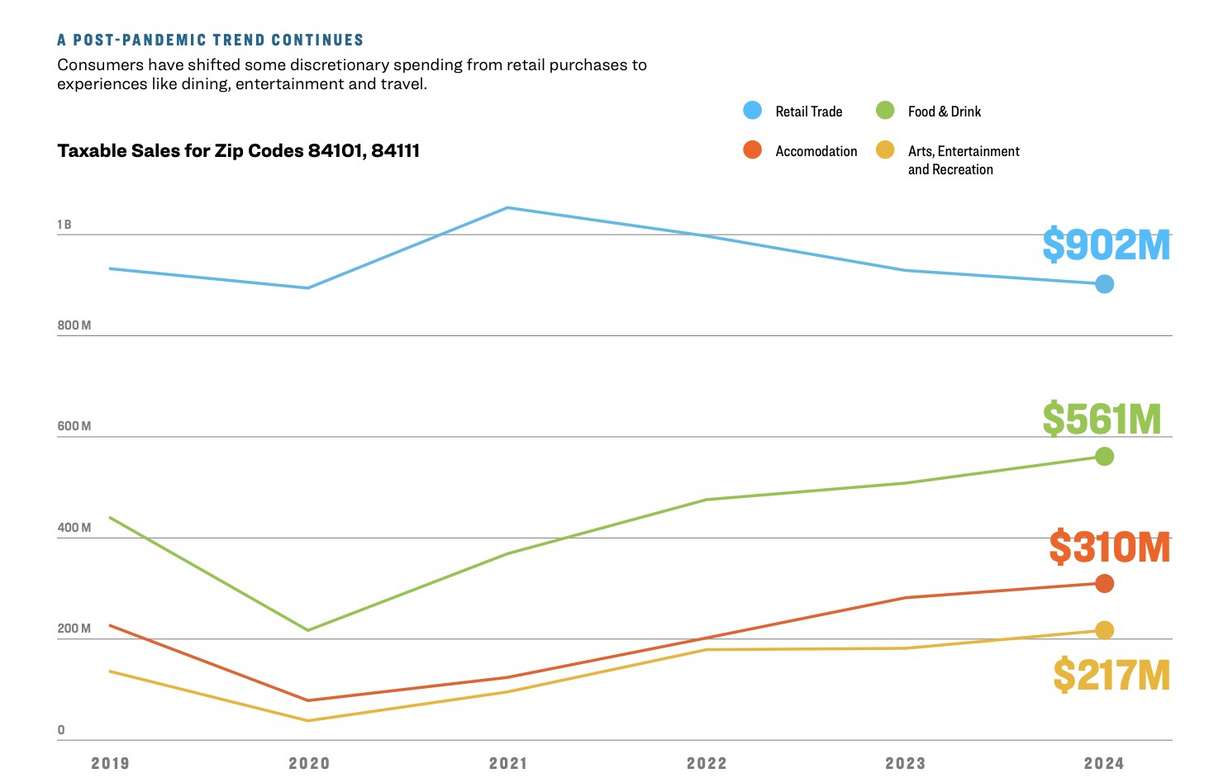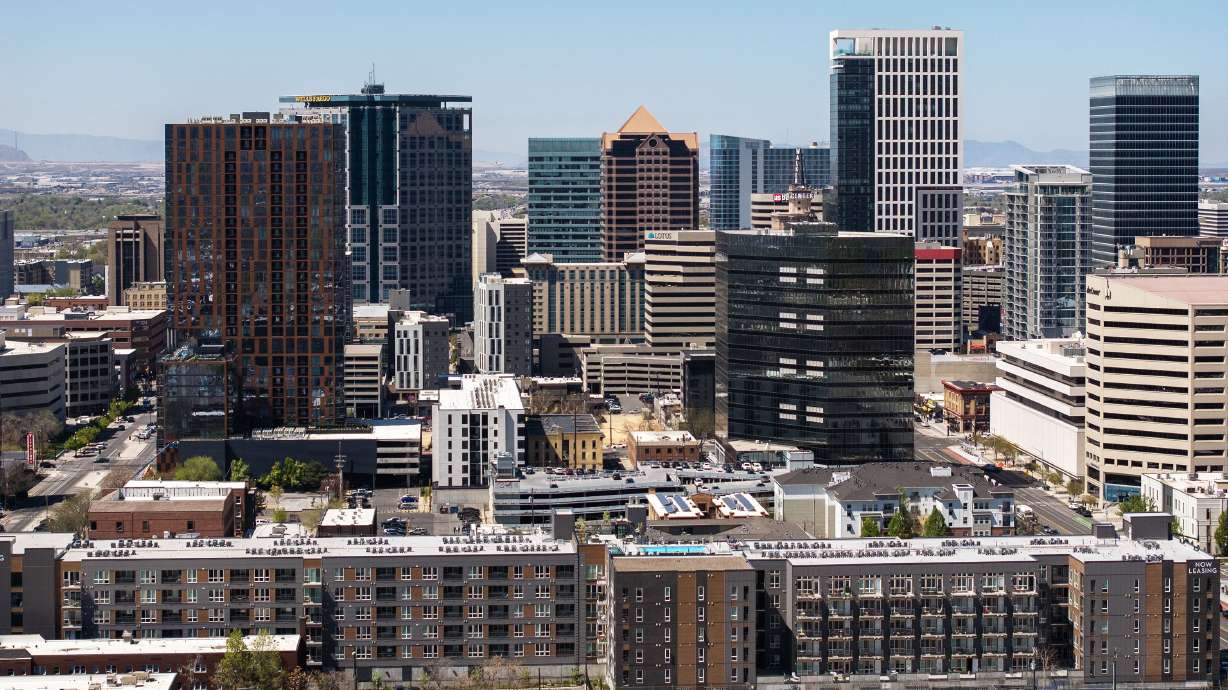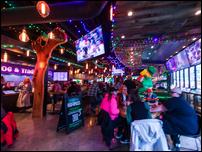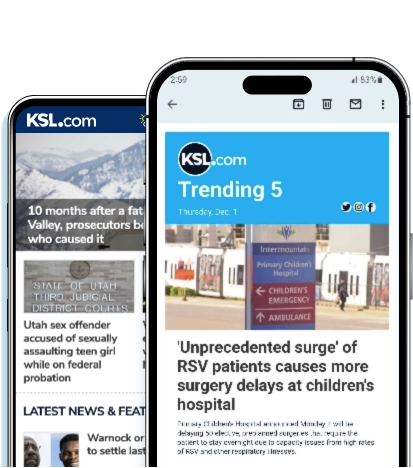Estimated read time: 5-6 minutes
- Salt Lake City's rapid growth is highlighted by its status as Utah's fastest-growing city.
- Downtown worker numbers haven't reached pre-pandemic levels, but other metrics have rebounded.
- Market trends and downtown revitalization plans could factor in the city's economic future.
SALT LAKE CITY — Mammoth isn't what Salt Lake City Mayor Erin Mendenhall had in mind if she were to name Utah's NHL team.
"I do love the Mammoth, but ... I was partial to the Cutthroats," she told a crowd gathered for the Downtown Alliance's annual State of Downtown event last month, referring to a buzzy idea that wasn't one of 20 official options when Smith Entertainment Group began searching for a name last year.
However, "mammoth" could be the best way to describe Salt Lake City's growth right now. The U.S. Census Bureau recently named it Utah's fastest-growing city of 2024, while the University of Utah's Kem C. Gardner Policy Institute notes that it is home to about one out of every four jobs in the state.
With projects to redevelop its Rio Grande, Ballpark and Fairpark neighborhoods all on deck, as well as major proposed changes to the University of Utah, Salt Lake City is well on its way to potentially become — as the institute described in 2023 — the country's next "great American city."
And yet, downtown remains the biggest area of interest. Between Temple Square renovations, the Smith Entertainment Group's revitalization plans and massive new residential developments, it's still at the center of the city's growth.
State of downtown
Despite the growth, downtown experts point out there is plenty of room to grow in some areas. The number of downtown workers has yet to reach pre-COVID-19 pandemic levels, but it is slowly showing signs of getting there.
Downtown workers accounted for about 6.2 million visits last year, about two-thirds of the volumes recorded in 2019 but up 10% from 2023, the Downtown Alliance noted in its annual economic benchmark report released during the May 22 event. However, more U.S. companies are planning to return to 100% in-person work within the next 18 months, per a Business Council survey included in the report.
Available higher-end office options downtown are starting to fill up with little major new office construction projects on the horizon, said Nadia Letey, senior vice president of the commercial real estate company CBRE, during a panel discussion about the report.
"People are coming back," she said. "It's going to get tight in inventory, and we have tenants in the market that are looking out well in advance of their (lease) expiration."
Meanwhile, development experts on the panel pointed to the University of Utah's $38 million acquisition of City Centre along 400 South and State Street last year as a sneakily significant change. They believe it will eventually draw in more people downtown once students and faculty move in, as the university creates a stronger downtown presence.

Other aspects of downtown have already surpassed pre-pandemic numbers.
- Taxable sales in the restaurant, accommodation and arts/entertainment industries are all on the rise, while retail trade taxable sales spiked in 2021 before sliding down in recent years to be closer to 2019.
- Over 4 million tickets were sold at downtown venues in 2024, an 18% increase from 2023 and the highest number since 2018.
- 2024 Salt Palace Convention Center attendance remains about 18% below 2019 levels, but Visit Salt Lake, Salt Lake County's tourism wing, reports that the annual number of hotel rooms sold downtown reached 2 million in 2024, up about 43% from 2019.
- Over 80% of the downtown's busiest days came when an event was happening at the Salt Palace.
It shows that conventions, sports and other entertainment have played vital roles in driving the downtown economy while downtown office workers slowly return.
"The Salt Palace alone generated over $400 million in economic impact, so it's really out-of-state dollars that others wouldn't have been spent here, and — in many cases — it's keeping locally-owned businesses afloat," said Visit Salt Lake communications director Ryan Mack.
The shape of downtown to come
A few trends could dictate what's next for Salt Lake City and its downtown core.
Inflation and high interest rates followed the pandemic, suppressing the desire to build more office spaces, said Andy Moffitt, senior commercial real estate specialist and partner at Mountain West Commercial Real Estate. That's carried over into other types of construction, leading to "uncertainty" across all types of projects, added Walker Wood, vice president of development for the residential developer Cole West.
That could pose future problems because more office and residential spaces are needed to help drive economic activity and bring down costs. It matters as more outside companies have expressed interest in moving into the market.
Related:
Future growth could also come down to "collaborative" planning between markets, Wood said. He isn't sure he can build new units without a strong office market or "interesting" restaurant and retail options. Those industries also rely heavily on filled residential units to be successful, but he believes the city is uniquely situated to handle the challenge.
"I do think one of the things that sets us up as a market is our ability to collaborate and find solutions," he said, adding that he'd like to see more ownership opportunities within the new downtown residential development.
Yet, all eyes remain on the Mammoth, Jazz and what happens with the redevelopment in and around the Delta Center.
Smith Entertainment Group began its three-year arena renovation project in April, which will include the groundwork for a 450-stall parking garage outside its southwest corner. It came as the company also purchased a section of the Salt Palace from Salt Lake County for $55 million, setting up for massive redevelopment of the neighboring convention center.
Although the convention center is already a big economic driver, Mack says there is room for improvement. Its one ballroom is already booked up over 80% of the year, which is fairly high in convention standards. The county wants to build a second ballroom while maintaining existing meeting and convention space, which he says will allow it to "stack" downtown conventions.
This will allow for more groups to hold events there and for Salt Lake to remain competitive with other Western cities.
"(It's) a huge opportunity for us," he said. "We estimate that's going to generate an additional $100 million-plus in economic development."










